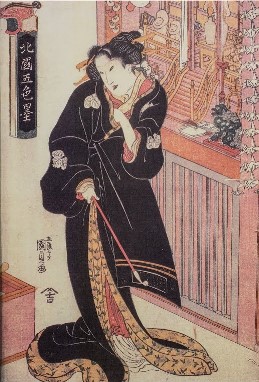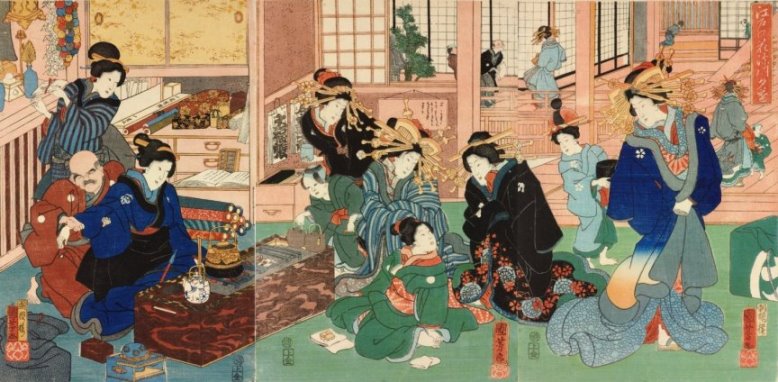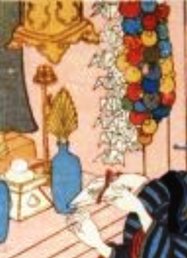| The Public Paperfolding History Project
x |
|||||||
| Strings of Cranes | |||||||
This page is being used to collect information about the practice of making hanging strings of Paper Cranes. Please contact me if you know any of this information is incorrect or if you have any other important information that should be added. Thank you. ********** 1818 This print from 1818, from the series Five Shades of Ink in the Northern Quarter (Hokkoku Goshiki-zumi), shows a Madam of a brothel (Naisho no Nyobou). The right hand side of the print shows a string of suspended Paper Cranes. The bottom crane has two smaller cranes suspended from its wing tips in Sembazuru Orikata style. Information from Origami in Ukiyo-e prints
********** c1860 This print by Utagawa Kuniyoshi, which can be dated to c1860, is of an evening scene at a brothel in Edo. A hanging string of Paper Cranes can be seen in the top left corner.
********** 1955 onwards In November 1954 an eleven year old Japanese girl from Hiroshima, called Sadako Sasaki, who had been just two at the time the USA had dropped an atomic bomb on that city in 1945, but who had survived because her family lived sufficiently far from the centre of the explosion, began to show signs of radiation sickness and was admitted to hospital. On August 3rd 1955 a number of paper cranes folded by well-wishers in Nagoya were sent to the hospital. Sadako began to fold her own cranes, symbolising her desire to get well. Sadako threaded the paper cranes she folded together into strings and hung them from the ceiling of her room in the hospital. By the end of August Sadako had folded 1,000 paper cranes, but she continued to fold more. Her condition continued to deteriorate and she died on October 25th 1955 having by then folded over 1300 paper cranes. Within three years of her death sufficient money had been raised to build a memorial to her in Hiroshima Peace Park. (Information from the website of the Hiroshima City virtual museum.) As a result of this, and a number of books and films about her, not all of which are very true to the facts, folding and stringing together a thousand paper cranes has become a common way to express a general desire for peace, or a more specific hope that nuclear weapons should never again be used. Many such strings are sent every year to the Hiroshima Peace Park to be displayed on or near Sadako's monument. Strings of a thousand paper cranes are also sometimes made as a more personal expression of good wishes for those who are unwell or dying. It is not altogether clear whether these various practices are a continuation of a pre-existing Japanese tradition or something completely new that has arisen as a result of the popularisation of Sadako Sasaki's story. ********** |
|||||||



